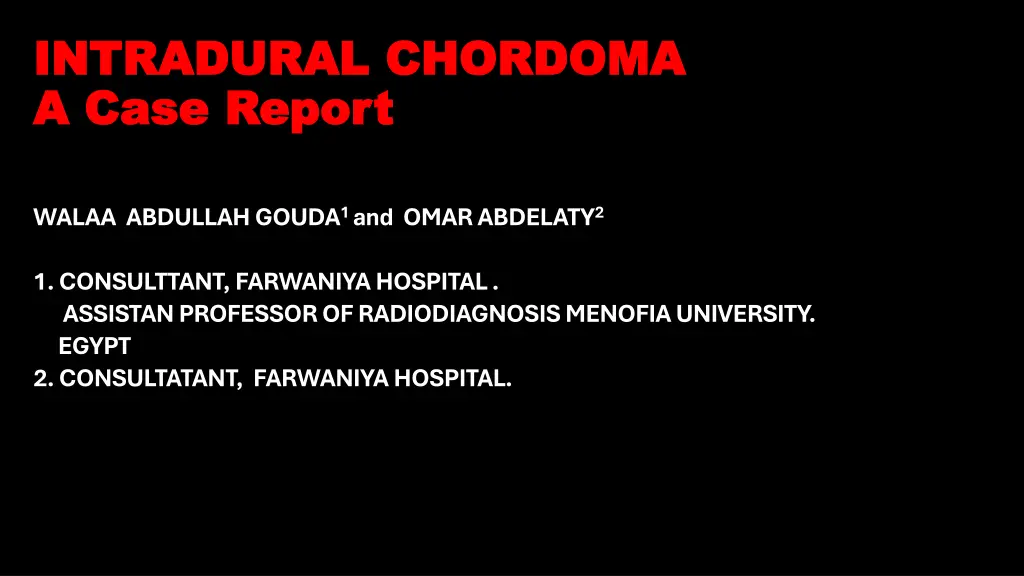
Juvenile Intradural Chordoma: A Rare Case Report
This case report discusses an 11-year-old male presenting with severe headache, diagnosed with juvenile intradural chordoma—an extremely rare tumor originating from notochordal remnants. Imaging findings, management options, and prognosis are detailed, highlighting the importance of close follow-up. Surgical resection is preferred to avoid radiation treatment, with an emphasis on potential cures and the biological continuum of these tumors.
Uploaded on | 1 Views
Download Presentation

Please find below an Image/Link to download the presentation.
The content on the website is provided AS IS for your information and personal use only. It may not be sold, licensed, or shared on other websites without obtaining consent from the author. If you encounter any issues during the download, it is possible that the publisher has removed the file from their server.
You are allowed to download the files provided on this website for personal or commercial use, subject to the condition that they are used lawfully. All files are the property of their respective owners.
The content on the website is provided AS IS for your information and personal use only. It may not be sold, licensed, or shared on other websites without obtaining consent from the author.
E N D
Presentation Transcript
INTRADURAL CHORDOMA INTRADURAL CHORDOMA A Case Report A Case Report WALAA ABDULLAH GOUDA1 and OMAR ABDELATY2 1. CONSULTTANT, FARWANIYA HOSPITAL . ASSISTAN PROFESSOR OF RADIODIAGNOSIS MENOFIA UNIVERSITY. EGYPT 2. CONSULTATANT, FARWANIYA HOSPITAL.
History: A 11-years-old male, presented by 5-days severe headache. Imagingfindings: CT shows an extra-axial midline non homogenous hypodense mass in the prepontine cistern with mild non homogenous post contrast enhancement and no evidence of lytic bone destruction. In MRI: The lesion is non homogenous predominantly hypointense on T1WI and hyperintense on T2WI with foci of high SI on T1WI and low SI on T2WI. It shows mass effect upon the brain stem with mild thumbing of the pons in sagittal plane (thumb sign or thumbing of the pons is describe in chordomas is meant to be relatively specific). It shows mild inhomogeneous enhancement after contrast administration with no restriction in DWIs. On SWAN images, it shows numerous foci of low signal intensity. Final diagnosis: Juvenile intradural chordoma. -Discussion: -Intradural chordomas are extremely rare tumors that originate from notochordal remnants. -Ecchordosis physaliphora (EP) is also an ectopic notochordal remnant that has a similar biological behavior and arises at the same location. Management and prognosis: Endoscopic-assisted procedure can achieve complete resection of an intradural chordoma offering a potential for surgical cure. Resection is particularly advantageous because it spares the young child the need for radiation treatment. Close follow-up is warranted because we postulate that this tumour exists in a biological continuum between benign notochordal hamartomatous remnants and typical invasive chordomas.
A C B D E G F H CT A& B: sagittal post contrast and bone window images showing mild non homogenously enhancing prepontine mass with mass effect upon the brain stem and with no bone destruction. MR images. C, D: Axial and sagittal T2-weighted showing an inhomogeneous hyperintense prepontine lesion with a mass effect on the brainstem and mild thumbing of the bone (green arrow). E: DWI shows no definite restriction and F: SWAN image with multiple foci of susceptibility artifacts seen within the lesion. G& H:Axial T1-weighted images before and after administration of gadolinium contrast showing mild inhomogeneous enhancement within the lesion.
References: 1. R.Saman Vinke, Elise Charlotte Lamers, Benno Kusters, et al. (2016) Intradural prepontine chordoma in an 11-year-old boy. A case report. Child s Nervous system volume 32, pages169 173. 2. Dow GR, Robson DK, Jaspan T, et al. (2003) Intradural cerebellar chordoma in a child: a case report and review of the literature. Childs Nerv Syst 19:188 191. 3. Chang SW, Gore PA, Nakaji P, et al. (2008) Juvenile intradural chordoma: case report. Neurosurgery 62:E525 E526 discussion E527 4. Zhang QH, Kong F, Guo HC, et al. (2010) Nasal endoscopic resection of extended intradural clival chordoma. Zhonghua Er Bi Yan Hou Tou Jing Wai Ke Za Zhi 45:542 546
